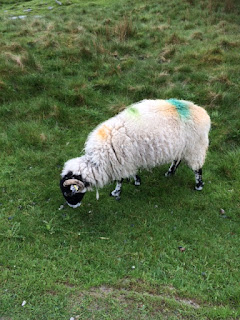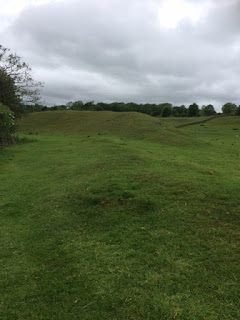Decided to ignore Sat Nav and drove the pretty route to Askrigg and on our way passed the National Trust property Fountains Abbey and Studley Royal Water Gardens. Had to stop. We were so lucky to visit on a gorgeous sunny day and were able to see the Abbey and beautiful gardens in two hours but we could easily have spent the day there. The Abbey ruins were so much larger than expected and the water gardens are truly beautiful. A real highlight for the start of our holiday in Yorkshire.
Our final destination - the small hamlet of Askrigg, Wensleydale. It is surrounded by lush greenery and settled in a tree-scattered valley that separates two stunning moorlands.
Mentioned in the Doomsday Book as Ascric, Askrigg had an important market before being granted a market charter in 1587 by Queen Elizabeth I. The market cross by the church is still to be seen.
Set into the cobbles nearby is a ring to which bulls were tethered to be baited. Apart from the 'sport' , such torment was thought to tenderise the meat.
Some houses around the church have decorated door lintels, one dated 1687, another 1694. The attractive, gently climbing main street of tall, handsome eighteenth and early nineteenth-century houses, contains the King's Arms dated 1767. One of the great characters in Wensleydale lived in what is now the hotel. John Platt built it as a private house and stables and lived there until his death in 1785. A great racing man, he started life as a jockey at Newmarket and later became a successful breeder.
It is one of the most famous tourist destinations in the dales, due to the well-known BBC TV series, All Creatures Great and Small. The filming of the series began in 1977, based on the books written by the Yorkshire vet Alf Wight under the guise of James Herriot. The series was shot mainly between the village of Askrigg (Darrowby) and Bolton Castle.
And we were so lucky to be staying at The Kings Arms itself, known during filming as Drovers Arms. Another thing to like about Yorkshire is the beer and Phil enjoyed tasting the eponymous local ale. His favourite Black Sheep. The bar is the heart of the King's Arms, with it's ancient stone floor, old beams and it's wide Yorkshire inglenook fireplace where Phil sat to test a selection.
Black Sheep Best Bitter, Yorkshire Dales Drover's Ale and Yorkshire Dale King's Arms Ale.
Having been introduced to the Yorkshire Dales by the romanticism of television shows such as Heartbeat, All Creatures Great and Small and Emmerdale, it certainly had a lot to live up to in my book. First impression - the rolling green hills and narrow winding roads contrasting with the bleak, but beautiful open Dales certainly make this a unique location and a lovely place to spend a few days.
So make a cup of Yorkshire tea and prepare to be delighted by the scenery of the Yorkshire Dales.
The first walk we did was around Askrigg to Mill Gill and Askrigg's Waterfalls, via Newbiggin.
The setting is one of immense beauty, much enhanced by the seemingly very healthy population of Curlews. Apparently the species breed on the moors during the summer.
The falls are about a mile apart and differ considerably. Mill Gill Force is a cataract, falling about 70 feet over a succession of ledges in an attractive sylvan setting. It hadn't rained for 8 weeks so not so spectacular.
However, the following day it was pouring with rain so we had a great trip from Settle to Appleby. The train passes through some amazing scenery. En route it passes over the Ribblehead Viaduct - a phenomenal piece of engineering with it's high arches. It would have been really special had carriages been hauled by a steam loco, but we instead travelled on a diesel unit. Found the stations, well kept, in their original condition. Full of nostalgia. A very pleasant and interesting trip but sadly no steam and smoke!
One advantage of pouring rain is it makes the waterfalls impressive. So decided to visit Hardraw Force - England's largest single drop waterfall, a reputed 100 foot drop, set within the grounds of the historic 13th century Green Dragon. The pub is very atmospheric, with low-beamed ceiling, local draught ales and a roaring log fire.
For a small charge (well worth it) we walked through the worn flag stone passage of the age-old pub and watched Hardraw Force. Apparently, Robin Hood, played by Kevin Costner on this occasion, bathed in the buff here! Robin Hood was nowhere in sight on our visit - too chilly - but a film crew was staying there.
We also had an adventurous car journey driving thro' Swaledale to the well-known 'Splash' ford in the titles of 'All Creatures Great and Small'. It is between Feetham and Langthwaite. Swaledale is the most northerly of the major dales and it has an austere beauty.
(Wensleydale is the most pastoral of the major dales, broad and green). We returned via Reeth and saw a black rabbit. Wild black rabbits are melanistic, that is having an increased amount of black pigmentation in their fur. Some people say that it is the opposite of being albino.
Using a book called Teashop Walks by Jean Patefield we decided to do walk 4 Aysgarth and the Falls. If you enjoy riverside walking, this one should be on your 'must do' list. However, an Ordnance Survey map is also useful as well, especially for identifying the main features of views and numerous dry stone walls. The network of dry stone walls across the landscape is one of the most eye catching and extensive man made structures with the Yorkshire Dales.
On this walk every wall had a squeeze stile - sometimes called 'fat man's agony'. Squeeze stiles are simply very narrow openings in the wall that a tall, skinny man can walk through, but would deter a sheep. We are talking a very tall, very skinny person here not short like me. Some were quite a squeeze. I suspect some stile builders have a wicked sense of humour. They combine the stile's narrowness at the top of the wall with a spring loaded gate. I called them "butt-slappers".
and too fat for this one, had to climb over:-
Anyway back to the walk.Much of the route is along the main river of Wensleydale, the Ure, near Aysgarth
and it includes the deservedly famous falls.
A delightful walk with some excellent views. Aysgarth is an ancient village, mentioned in the Domesday Book, the name meant 'clearing in the oaks'. As the path brings you into Bishopsdale you can see the broad U shape of the valley. This was formed by the erosive force of the glacier which filled the valley in the Ice Age. When the ice melted the valley was filled with a lake and the silt deposited has given it a fertile floor. In the Middle Ages, Bishopsdale was part of the Honour of Middleham and reserved as a hunting chase. Farming only started in the 17th century when Middleham's ownership ended.
The high ground bordering the river is a terminal moraine left as the glaciers retreated at the end of the Ice Age and it once impounded a huge lake in Wenleysdale. Eventually, the rive Ure broke through and eroded down to the bedrock. The rock here is alternating layers of resistant limestone and softer shale. The water has eroded into the shale and eventually the limestone has broken off, forming a series of attractive step-like falls.
We then stopped for refreshments - Yorkshire tea and toasted teacakes dripping with butter at Mill Race Teashop an 18th century building. Yore Mill next door has had a chequered history. It was built as a cotton mill in 1784 then switched to corn and wool. A long mill race brought water from above the High Force to power a water wheel. Burned down in 1853, it was rebuilt twice as big. It is said to have produced the cloth for the red shirts worn by Garibaldi's revolutionary army in Italy. The water wheel was removed in 1937 and milling finished in 1959. It is now a craft shop.
We then drove home via Semer Water.
On our last day we visited Malham and did walk 15 in the Teashop Walks book. It was an outstanding walk and the limestone scenery is breathtaking. We started at Malham Tarn and visited all the fascinating geological features.
This walk had the inevitable hills - they add enormous interest and with no hills there are no views. However, this did not present a problem as I have three uphill gears - slowly, very slowly and admiring the view. Phil was very understanding - I am sure he could have powered on ahead but Wainwright, the doyen of walkers, said that he never had a serious fall in all his years and thousands of miles of walking because he always looked where he put his feet and stopped if he wanted to admire the scenery. Advice I definitely follow. Instead of squeeze stiles we came across stone stiles on this walk. Stone stiles are constructed by inserting stone steps on both sides of the wall, so you walk up, step onto the top of the wall and walk down. A fine concept, except that the bottom steps seem to always be way too high for me and covered in sheep pooh. Not to mention that I have got my walking poles dangling from my hands!
Gordale Scar is one of the outstanding sights of the Dales. The deep, narrow chasm was formed by the torrential melt water from the glaciers of the last Ice Age eating away at a pre-existing fault in the rock. It now has quite a small stream and such a spectacular gorge could not have been formed by the small beck we see today.
Next it was over to Janet's Foss which is not a high waterfall but must rank among the most attractive in the National Park. The name 'Janet' is a corruption of 'Jenet', the Queen of the Fairies who was reputed to live in a cave behind the cascade; "foss" derives from force, a Yorkshire word for a waterfall.
We then stopped for refreshments at Beck Hall in Malham across the clapper bridge.
Relaxed in the sunshine by the babbling beck. Delightful. Built in 1705 and originally a Dales Yeoman's cottage.
After lunch two stiff pulls to Malham Cove which is unique and breathtaking. It lies on the Middle Craven Fault, a crack or fault in the Earth's crust. The softer rocks to the south have dropped and been eroded leaving the escarpment as a prominent feature of the landscape. The actual line of the fault is just a little to the south of the cove as the rocks have been eroded back over the centuries. The exact geological processes which formed the Cove have been the subject of much speculation but it must have been an usual combination of ice, water and earth movements.
We climbed a well constructed series of steps,(400) built to combat the erosion of visitors' feet. At the top we followed a path onto the limestone pavement. It was very impressive and unlike anything else I've seen. However, the uneven rock formations are ankle breakers. I had to be exceedingly careful scrambling about the rocks! This walk was not an easy stroll but the view was worth it.
A peregrine falcon, Britain's most impressive bird of prey, flew overhead. Since 1993 they have nested at Melham Cove.
We then walked back to our car through a narrow dramatic gorge to some more steps to climb out of the valley.
Fabulous holiday and after all that exercise - steak and ale pie. OMG.






































































No comments:
Post a Comment